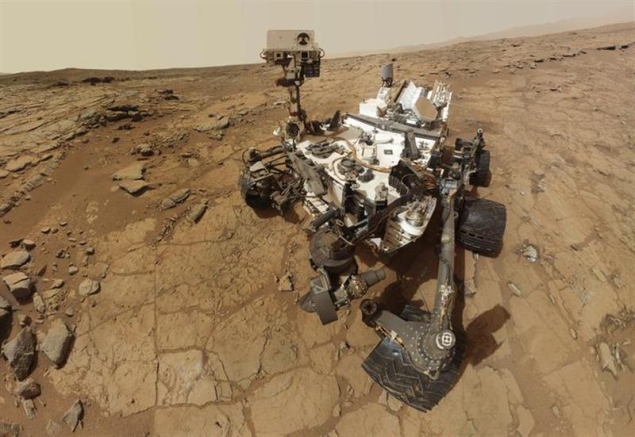- Home
- Others
- Others News
- NASA's Curiosity rover finds 'abundant' water on Mars
NASA's Curiosity rover finds 'abundant' water on Mars

Curiosity touched down Mars last August and began its 100-day mission of collecting and analysing samples of all kinds in Gale crater, which is near the Martian equator, with its high-tech lasers and scoops.
(Also see: Mars rover Curiosity lands on surface of Red Planet)
In this study, researchers from the Rensselaer Polytechnic Institute used the rover's scoop to collect dust, dirt and finely grained soil from a sandy patch known as "Rocknest".
The researchers then fed portions of the fifth scoop into an instrument onboard Curiosity called the Sample Analysis at Mars (SAM) to heat them to 835 degrees Celsius.
(Also see: NASA's Curiosity rover gets first Mars rock samples)
"One of the most exciting results from this very first solid sample ingested by Curiosity is the high percentage of water in the soil," said lead author Laurie Leshin, dean of science at the institute.
"About two percent of the soil on the surface of Mars is made up of water, which is a great resource, and interesting scientifically," Leshin said.
The sample also released significant carbon dioxide, oxygen, and sulfur compounds when heated, the researchers reported in the journal Science.
Baking the sample also revealed a compound containing chlorine and oxygen, likely chlorate or perchlorate, previously known only from high-latitude locations on Mars. This finding at Curiosity's equatorial site suggests more global distribution, the researchers said.
In addition to determining the amount of the major gases released, SAM also analysed ratios of isotopes of hydrogen and carbon in the released water and carbon dioxide.
Isotopes are variants of the same chemical element with different numbers of neutrons, and therefore different atomic weights.
The analysis found that the ratio of isotopes in the soil is similar to that found in the atmosphere analysed earlier by Curiosity, indicating that the surface soil has interacted heavily with the atmosphere.
"The isotopic ratios, including hydrogen-to-deuterium ratios and carbon isotopes, tend to support the idea that as the dust is moving around the planet, it's reacting with some of the gases from the atmosphere," Leshin said.
The results shed light on the composition of the planet's surface, while offering direction for future research, said Leshin.
"Mars has kind of a global layer, a layer of surface soil that has been mixed and distributed by frequent dust storms. So a scoop of this stuff is basically a microscopic Mars rock collection," said Leshin.
"If you mix many grains of it together, you probably have an accurate picture of typical martian crust. By learning about it in any one place, you're learning about the entire planet."
These results have implications for future Mars explorers. "We now know there should be abundant, easily accessible water on Mars," said Leshin.
"When we send people, they could scoop up the soil anywhere on the surface, heat it just a bit, and obtain water."
For the latest tech news and reviews, follow Gadgets 360 on X, Facebook, WhatsApp, Threads and Google News. For the latest videos on gadgets and tech, subscribe to our YouTube channel. If you want to know everything about top influencers, follow our in-house Who'sThat360 on Instagram and YouTube.
Related Stories
- Galaxy S24 Series
- MWC 2024
- Apple Vision Pro
- Oneplus 12
- iPhone 14
- Apple iPhone 15
- OnePlus Nord CE 3 Lite 5G
- iPhone 13
- Xiaomi 14 Pro
- Oppo Find N3
- Tecno Spark Go (2023)
- Realme V30
- Best Phones Under 25000
- Samsung Galaxy S24 Series
- Cryptocurrency
- iQoo 12
- Samsung Galaxy S24 Ultra
- Giottus
- Samsung Galaxy Z Flip 5
- Apple 'Scary Fast'
- Housefull 5
- GoPro Hero 12 Black Review
- Invincible Season 2
- JioGlass
- HD Ready TV
- Laptop Under 50000
- Smartwatch Under 10000
- Latest Mobile Phones
- Compare Phones
- Huawei Pura 70 Pro
- Huawei Pura 70
- Vivo V30e
- Itel Super Guru 4G
- Huawei Pura 70 Pro+
- Huawei Pura 70 Ultra
- Tecno Camon 30 Premier 5G
- Motorola Edge 50 Fusion
- Asus ZenBook Duo 2024 (UX8406)
- Dell Inspiron 14 Plus
- Realme Pad 2 Wi-Fi
- Redmi Pad Pro
- Cult Shock X
- Fire-Boltt Oracle
- Samsung Samsung Neo QLED 8K Smart TV QN800D
- Samsung Neo QLED 4K Smart TV (QN90D)
- Sony PlayStation 5 Slim Digital Edition
- Sony PlayStation 5 Slim
- Voltas 1.5 Ton 3 Star Split AC (183 Vectra Elegant 4503545)
- Hitachi 1.5 Ton 5 Star Inverter Split AC (RAS.G518PCBISF)

















